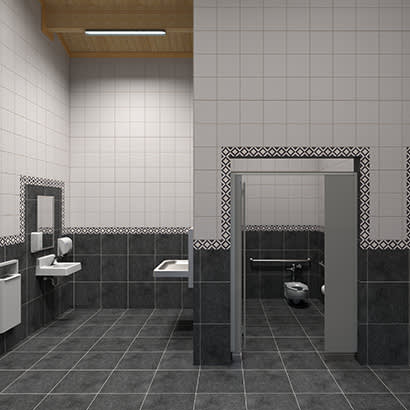
For an enhanced digital experience, read this story in the ezine.
Today’s demand for all-gender public restroom buildings runs parallel with the trend of transitioning from multiuser restrooms to multiple single-user restroom spaces within the same building. The multiuser designs have declined in popularity except in applications involving a high number of users per hour. This type of design is ideal for maximizing the allowable floorspace to provide use to the largest number of occupants at a given time — for example, during half time at a big football game, at a concert or entertainment venue, or at the airport — whereas the “single user” layout has grown in popularity in many designs.
The Single-User Design
The single-user design’s rise in popularity is due primarily to the privacy, security and overall space maintenance this layout provides. Most single-user rooms are unisex. Once inside, the space provides toileting and washing fixtures along with the pertinent accessories to assist most users. This area allows the individual to maintain privacy as they have the room all to themselves until they leave the space. This feature is also very popular in many all-gender designs. In fact, one certainly can take the position that all single-user designs are also all-gender.
All-gender designs with a common entry and handwashing accommodations in a common/open area present a new way to design and build public restrooms for multiple users. This approach provides many of the single-user benefits while eliminating the single-user features that owners despise — primarily, the lock on the door and no real way of knowing who’s in there or for how long.
Looking closely at the all-gender design pictured above, a stall door is the only real privacy afforded in this design. Additionally, the stall door to the toileting fixture should be equipped with occupancy indicator hardware and an increased undercut to allow visibility of the users’ feet. This provides a sense of privacy that will encourage the user to use the available space punctually. Additionally, since the water closet or urinal is the only fixture in the stall, the user will be more inclined to gravitate out to the common area for handwashing, personal hygiene and preening. By moving the handwashing out of the toilet fixture space, we can move people faster through the toilets and provide a separate common area for all-gender handwashing, which expedites the handwashing task at the sink and mirror and, in turn, keeps the total time in the restroom to a minimum.
Considerations
The various layouts and designs have both good and bad aspects. While no design is perfect, it’s important to consider some of the following:
- Where will this restroom be located?
- What is the main use of this facility?
- How many people will it need to accommodate?
- When will this restroom be the busiest?
- How frequently will that occur?
If these questions are answered correctly and implemented into the proposed design, the size and occupancy load will be adequate. For example, in most cases, from highway rest areas to campgrounds to a sports complex, it’s rare to ever wait in line to use the restroom. In other words, the owners typically are taking all these design considerations and requiring proposed buildings to have a larger quantity of restrooms with bigger restroom-use capacity than is really required to provide adequate use for its occupants.
What the public prefers will likely serve as the basis of design and direct the change or requirements for each public space. That is what has driven the growth in popularity of single-user designs. Currently, the public prefers all-gender facilities that are evolving to include specific spaces to oblige the family unit with baby changing accessories, as well as accessible adult changing rooms with all the pertinent accommodations. These demands are changing public restroom buildings to all-inclusive, multiuser, all-gender spaces.
Benefits of All-Gender Facilities
For owners and maintenance personnel, one of the greatest concerns regarding public restrooms is vandalism. Not only are the new all-gender designs more inclusive, but also they reduce vandalism by providing a space for all. In planning universal common areas, restroom staff will have the ability to provide more oversight while facilities are open to the public. This will allow for no lapse in general cleaning procedures, the prompt awareness of a fixture failure, and the ability to address the issue by closing a certain stall or isolating a portion of the space.
Design Examples
For the Cedar Links Park restroom near Medford, Oregon, the number one concern was vandalism. The project combined what is essentially a typical multiuser design with a single vandal-proof entrance that when opened provides easy access to the vestibule area with a high-low drinking fountain alcove and split-entry access to the restrooms. This entrance provides an attractive open feel and visibility for both users and maintenance personnel.
Sharing the same concerns with vandalism as Medford, a similar design concept was required for the Exchange Park restroom in Decatur, Georgia. The plan combined what is commonly an all-gender design with a single vandal-proof entrance that when opened provides easy access to a common entry for both the restrooms and the mechanical room. This entrance also provides an attractive open feel and visibility for both users and maintenance personnel.
From big buildings to small buildings in restroom and shower buildings, the single-user popularity is driving the new construction of all public restroom and shower buildings toward all-gender spaces for most new designs.
Cassandra Ruport is Lead Technical Designer at Romtec, Inc.

